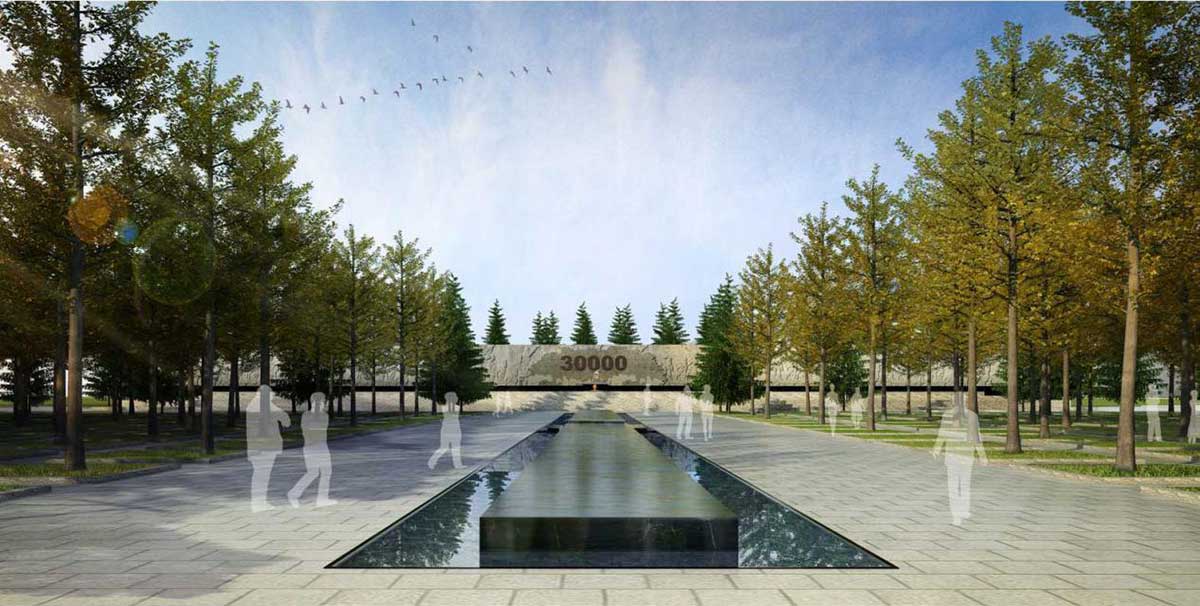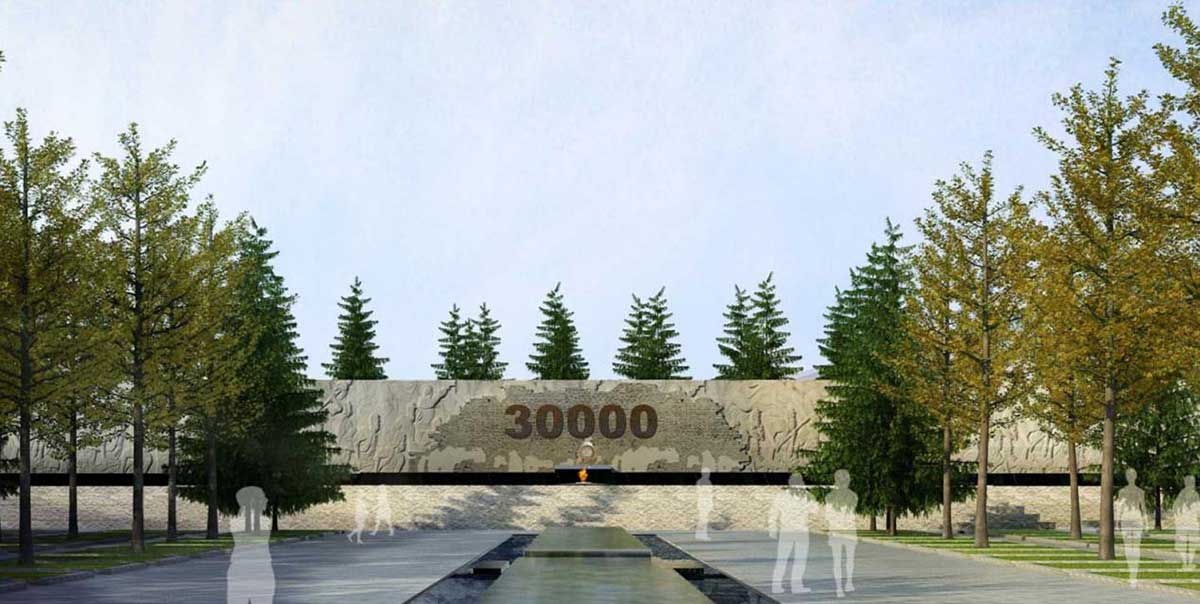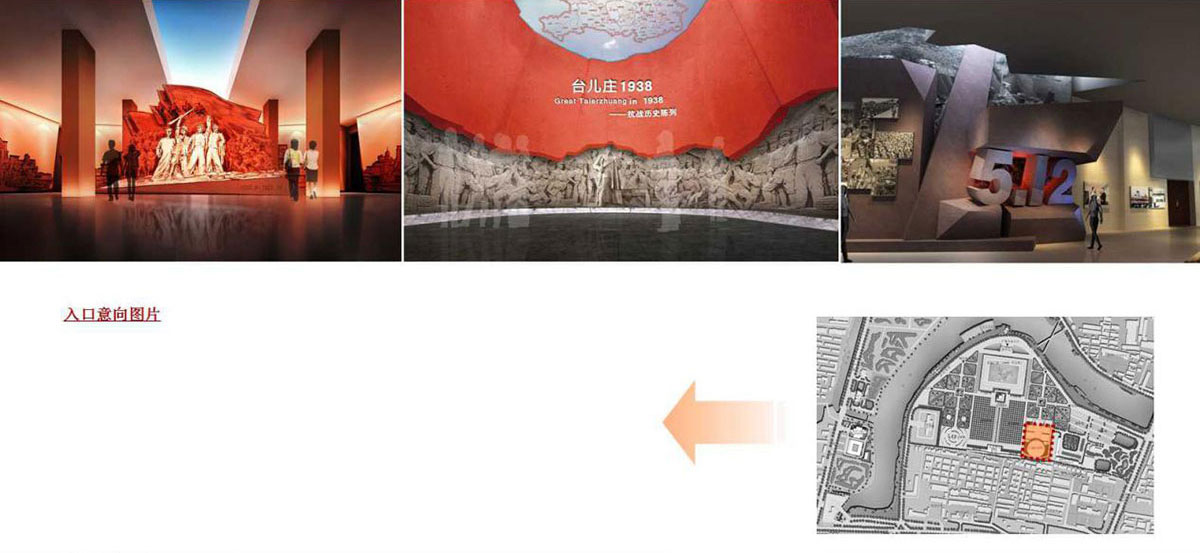
台儿庄大战主题景区
台儿庄大战主题景区规划设计
Designing of Scenic Spot with Taierzhuang War as the Theme
项目面积:用地面积约10万平方米
Area: around 100,000 square meters
项目地址:山东省枣庄市
Site: Zaozhuang, Shandong
项目类型:抗战历史文化主题景区
Category: war and historic culture scenic spot

五大轴线推演过程 :“山川之意”。本案的整体规划之中,在主轴线和辅助轴线的推演过程中融入了山川之意的理念,借此体现中华民族团结一心,气盖山河的民族精神,寓意中华民族的伟大精神生长于神州大地的山川之中,又流淌、传承于中华神州大地,生生不息。设计要点:
本案是为纪念中国抗日战争胜利七十周年暨世界反法西斯战争胜利七十周年而设计的地标性建筑规划项目,具有重要的历史意义和文化意义。本案以中国抗日战争胜利为历史背景,以”铭记历史、缅怀先烈、珍视和平、警示未来”的精神内核为主题,意在纪念和缅怀在台儿庄大战时为国捐躯的抗日先烈和事迹,以此来弘扬中华民族精神,增强民族凝聚力。
This project is a landmark architectural planning to celebrate the 70thanniversary of the triumphant anti-Japanese war in China, also the 70thanniversary of Global War against Fascism. It carries major historic significance and cultural heft. With triumph of anti-Japanese war as the historic ambiance and the spiritual connotation of ‘memorization of history, remorse on the martyrs, cherishing of peace and warning to the future’ as the theme, it is to memorize martyrs who sacrifice their life in Taierzhuang War and their stories in a bid to carry forward the spirit of the Chinese nation and enhance national cohesion.

规划构思:
Planning and configuration:
Five shafts: ‘intention of landscape’. The concept of intention of landscape is integrated in the derivation process of main shaft and supplementary shaft in a bid to reflect unity of the Chinese nation and its expansive national spirit. It implies that the great spirit of the Chinese nation incessantly takes roots in landscape and is seen in the swath of land of China. Its designing points are seen below:

本案充分考虑历史、政治、文化、场地、经济等相关因素及条件,汲取我国传统建筑文化的精髓,设立主轴线和辅助轴线,并以轴线两侧对称的空间布局,融合民族团结的精神导向,兼容古典的哲学思考和现代的设计理念,诠释出一个饱含民族精神文化与时代感的设计方案。
This program gives full consideration to historic, political, cultural, site and economic factors and conditions, imbibes essence of traditional architectural culture, sets up main shaft and supplementary shaft, integrate the spiritual orientation of national unity with symmetric spatial layout by the two sides of the axes and account for a designing plan rich in national ethos and modernity.

纪念墙的整体设计采用圆形,各弧形纪念墙以圆点为中心,有向心力、凝聚力、团结的寓意,象征民族团结,祖国统一。同时圆形的设计在整体平面布局上与台儿庄大战纪念馆建筑相呼应,纪念墙上雕刻节选世界各地名人志士对台儿庄大战的评价、评语;以及台儿庄大战的光荣事迹等,起到弘扬爱国主义精神、促进民族团结的作用。
Roundness is applied to the overall designing of the memorization wall. With bold dot as the center, arc-shaped memorization wall carries the significance of cohesion and unity. It symbolizes national unity and unification of the country. In overall planar layout, round designing chimes with the memorization building of Taierzhuang War. The memorization wall is engraved with comments and remarks of celebrities the world over on Taierzhuang War as well as legendary stories on the war. It displays the effect of carrying forward patriotism and propelling national unity.

层层递进的百米步道,由两旁的树林相互簇拥,中间与安静的水景相结合,营造出肃静,庄严,仪式感强烈的缅怀氛围,水寓意着民族之精神,生生不息。主体雕塑:以体现民族“团结抗战、共御外侮”的精神为主,真实再现在中国共产党倡导建立的以国共合作为基础的抗日民族统一战线旗帜下,中国人民同仇敌忾、共赴国难,铁骨铮铮、视死如归的历史画卷。
The progressive hundred-meter walking track is clustered by trees at its two sides. It is connected to the quiet waterscape in the middle to bring out a solemn, quiet and ritual atmosphere of memorization. Water implies national spirit that lasts. The main body sculpture is dominated by reflection of the nation’s ‘unity to counter against foreign intrusion’. It is true representation of the historic picture scroll of people’s fighting in unity against foreign intrusion by sacrificing their lives under the banner of Chinese united front against Japanese aggression with Kuomintang-Communist cooperation as the basis.

室内展陈空间:
Indoors layout:
展陈将以弘扬伟大的抗战精神为宗旨,以铭记历史、缅怀先烈、珍视和平、警示未来为目的,真实再现在中国共产党倡导建立的以国共合作为基础的抗日民族统一战线旗帜下,中国人民同仇敌忾、共赴国难,铁骨铮铮、视死如归的历史画卷。
With carrying out the great anti-Japanese war as tenet, the display is aimed at remembering history, memorizing the martyrs and warning the future. It is true representation of the historic picture scroll of people’s fighting in unity against foreign intrusion by sacrificing their lives under the banner of Chinese united front against Japanese aggression with Kuomintang-Communist cooperation as the basis.



